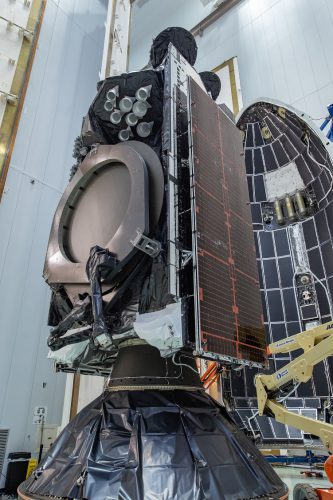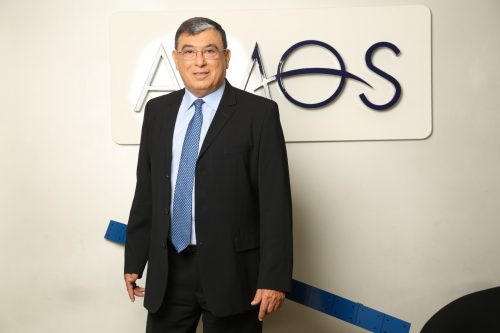According to the CEO of the space company, David Polak, that the satellite was built in the Boeing factories in California, since the company was obliged to comply with the schedule for placing a satellite at this point in the sky, which is over central Africa, because otherwise the World Telecommunication Union would transfer the point to another purpose

For the first time since the explosion of Amos 6 and even earlier, the sudden shutdown of Amos 5: Amos 17 will be launched next Sunday from Cape Canaveral using SpaceX's Falcon 9 launcher. The spacecraft itself was built by the Boeing company.
Amos 17 got its name from the point in the sky where it will be placed - 17 degrees east, above the equator, it replaces Amos 5 which provided services from this point in the sky, but suddenly ceased to operate in 2015. Amos 6, on the other hand, is replaced by a satellite leased for communication space by Asia -Sat and Amos machine 7.
At a press conference held this morning at the offices of the Space Company in Berlin, the CEO of the Space Company, David Polak, said that the satellite was built at the Boeing factories in California, since the company was obligated to meet the schedule for placing a satellite at this point in the sky, which is over central Africa, because otherwise a union might International Telecommunication Union (ITU) assign the point to another purpose.

According to Boeing, it was the only one that committed to meeting the schedule. In preparation for the upcoming launch, and in order not to repeat the mistake made with Amos 6, it was decided not to put the satellite on the launcher as long as experiments are being carried out on the launcher itself.
Africa is a huge continent, explains Eran Shapira, manager of technology business initiatives in the communications space. Within the continent, the territories of countries such as the USA, China and Japan enter - and there is still an excess (the reason why this is less noticeable on the map is that the closer a country is to the equator it looks smaller, and vice versa - Greenland is drawn on maps much larger than it really is AB)
The rate of population growth in Africa is very fast. By the middle of the century, 2.5 billion people are expected to live there, a number similar to the population of Asia today). By the middle of the century Africa and Asia are going to be equal in terms of population. Africa's population is the largest young population projected in this century. This of course raises the demand for content and communication.
The common assumption that African economies are not in good shape, and certainly not growing, is also not true. The average GNP of African countries is rising nicely despite the population growth, which means that there is no shortage of money for the communications sector.
The main problem in Africa, due to the continent being huge, it is very difficult to deploy communication infrastructure there. The proportion of parents' homes to which terrestrial internet reaches is barely 7 percent of the continent's territory. The wired and cellular communication infrastructure may be good enough in the cities, but already in the suburbs and especially in the rural areas, the reception is decreasing. The only solution for wide deployment is satellite terminals. It is possible to connect such a terminal to a solar system and connect a village or town that was not previously connected to the cellular network via satellite.
The weight of the satellite at the time of launch is 6.5 tons, some of which were subsequently released upon its arrival in orbit after the separation from the second stage of the launcher, and the rest will be used for maneuvers to remain in orbit and prevent drifting during its planned twenty years of service. The length of the satellite when the cellular panels are open will reach 35 meters. More than 400 working hours were invested in the construction of the satellite and it underwent more than ten thousand tests. The cost of bringing it to heaven, including the launch and insurance, will reach 250 million dollars.
Before the launch of the Amos 6 satellite, the space company signed an agreement with Facebook according to which it would buy the internet capacity to provide internet to Africa. However, after the satellite exploded on the launch pad, Facebook changed its policy and is purchasing partial capacities from many satellites, to avoid dependence on one satellite.
However, Polk says: "We had an amazing agreement with Facebook, we designed beams for them to Africa. The agreement with Facebook for internet for everyone in Africa was a dream for me. We lost it, it's a shame, but we learned from it, and I hope we can sign an agreement to sell capacity to Facebook from Amos 17, but as mentioned, Facebook does not order capacity before the satellite starts operating.
In response to the science site's question as to whether there is any progress in the direction of building a new satellite by the aerospace industry to replace Amos 6 with the Israeli government's subsidy, Pollak answered: "As far as government decisions and the aerospace industry are concerned, I prefer not to comment." I don't always understand their logic."
More of the topic in Hayadan:
- Space Communications ordered the "Amos 17" satellite from Boeing for $161 million
- Space Communications canceled the contract for the production of Amos 8 in the USA, and with a high probability of transferring it to the aviation industry
- Explosion at the SPACEX launch pad at Cape Canaveral * Prof. Ben Israel: the Amos 6 satellite was destroyed

4 תגובות
Dangerous situation, caution
A huge risk
Indeed, it should probably be "17 degrees east of the longitude of Greenwich".
By virtue of being a geostationary satellite, it is located exactly above the equator.
And one more thing: its location is 17 degrees east of Greenwich, not west. which is over Africa, and not over the Atlantic Ocean.
"Amos 17 got its name from the point in the sky where it will be placed - 17 degrees west of the equator" - needs to be corrected. The equator is a line of latitude and relative to it should be "north" or "south" (and not "west").